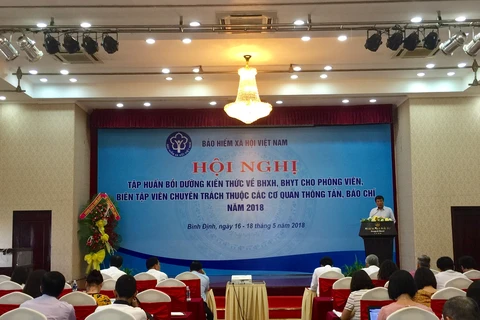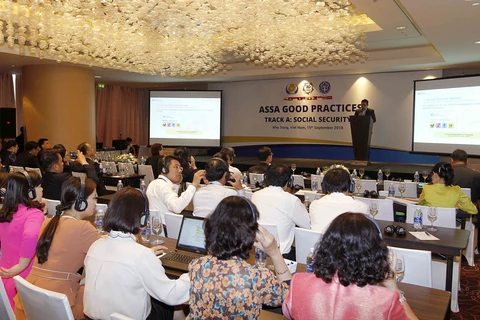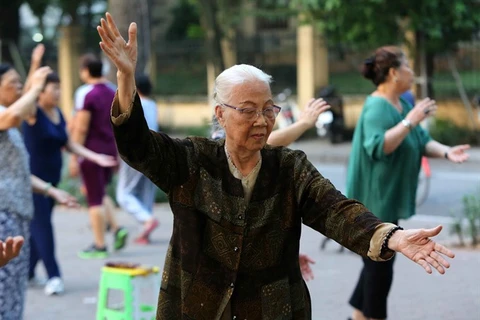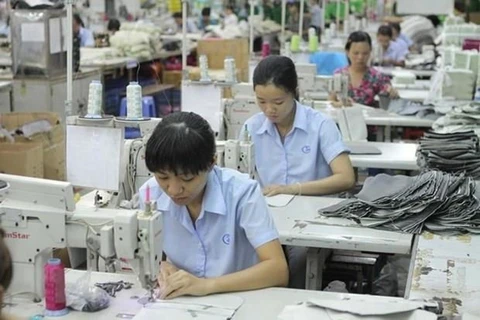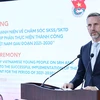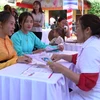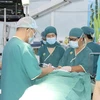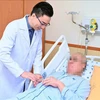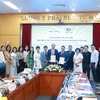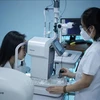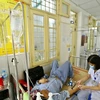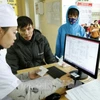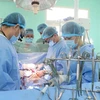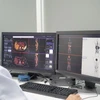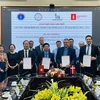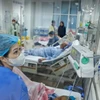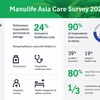Bac Giang (VNA) – Up to 98 percent of the 1,024 HIV carriers in the northern province of Bac Giang are receiving antiretroviral (ARV) drugs covered by health insurance (SHI), heard a medical event in the province on March 15.
A project on HIV/AIDS treatment with the participation of health facilities and prisons was launched on the occasion, which comes under the sponsorship of the US-based AIDS Healthcare Foundation (AHF).
In addition to providing equipment to clinics, the project will arrange advanced refresher courses for medical workers at the grass-root level to improve quality of HIV/AIDS testing and treatment.
Director of the provincial Centre for Disease Control and Prevention Dang Thanh Minh said there were more than 3,270 HIV carriers in the province as of the end of February, nearly 1,980 of them still alive.
HIV patients need lifelong treatment that can be costly, and early and continuous treatment enables them to lead healthy lives and effectively eliminates the risk of transmission through sexual intercourses.
Historically, ARVs were provided free-of-charge in Vietnam through international donors. However, over the last five years, the US President’s Emergency Plan for AIDS Relief (PEPFAR) programme, through its activities, has been working with the Government of Vietnam to transition the responsibility for financing the country’s HIV response from donors to SHI.
Key in the transition was revising the Social Health Insurance Law and benefit package to include funding for HIV treatment; integrating HIV clinics in the public health system; increasing the number of HIV patients enrolled in SHI from 40 per cent in 2014 to 89 per cent in 2018; procuring ARVs through SHI; and creating procedures for HIV services reimbursement by SHI.
Across the world, very few developing countries are applying their SHI programmes to cover HIV treatment services. Among the PEPFAR focused countries, Vietnam is the only country mobilising domestic resources through SHI to cover HIV treatment services. This can be attributed to the Government of Vietnam’s strong commitment to the long-term sustainability of its HIV/AIDS response.
Vietnam is also a global leader in achieving viral suppression, at 93 percent. Viral suppression is a measurement of the degree to which the virus is in a person’s bloodstream.
When an HIV positive patient achieves viral suppression and has an undetectable viral load, not only do they have a significantly increased likelihood of improved health outcomes, but it also eliminates their likelihood of transmitting HIV.
In 2018, about 10,000 new HIV carriers were detected in Vietnam, including 2,000 fatalities, equivalent to those in the previous year.
The figure has so far raised the total number of living HIV patients to 208,800; up to 94,900 of them developed into AIDS and 98,500 were dead. The rate of HIV/AIDS infection was curbed below 0.3 percent.
The health sector launched awareness campaigns nationwide with hundreds of articles featuring HIV diagnosis and treatment towards the goal of diagnosing 90 percent of all HIV-positive persons, providing ARV therapy for 90 percent of those diagnosed and achieving viral suppression for 90 percent of those treated by 2020, thus eliminating AIDS by 2030 and using health insurance for HIV patients.
More than 1,300 medical stations nationwide are offering HIV testing services while ARV treatment is available in all the cities and provinces nationwide, with clinics offering the treatment rising from 401 in 2017 to 429 in 2018. ARV medicines were distributed at 652 medical stations, 32 prisons and two detention centres.
The rate of HIV/AIDS-infected patients joining health insurance has increased from 50 percent in October 2016 to nearly 90 percent now. All patients under ARV treatment in Ninh Thuan, Lai Chau, Cao Bang and Ca Mau provinces have been covered by health insurance.-VNA
A project on HIV/AIDS treatment with the participation of health facilities and prisons was launched on the occasion, which comes under the sponsorship of the US-based AIDS Healthcare Foundation (AHF).
In addition to providing equipment to clinics, the project will arrange advanced refresher courses for medical workers at the grass-root level to improve quality of HIV/AIDS testing and treatment.
Director of the provincial Centre for Disease Control and Prevention Dang Thanh Minh said there were more than 3,270 HIV carriers in the province as of the end of February, nearly 1,980 of them still alive.
HIV patients need lifelong treatment that can be costly, and early and continuous treatment enables them to lead healthy lives and effectively eliminates the risk of transmission through sexual intercourses.
Historically, ARVs were provided free-of-charge in Vietnam through international donors. However, over the last five years, the US President’s Emergency Plan for AIDS Relief (PEPFAR) programme, through its activities, has been working with the Government of Vietnam to transition the responsibility for financing the country’s HIV response from donors to SHI.
Key in the transition was revising the Social Health Insurance Law and benefit package to include funding for HIV treatment; integrating HIV clinics in the public health system; increasing the number of HIV patients enrolled in SHI from 40 per cent in 2014 to 89 per cent in 2018; procuring ARVs through SHI; and creating procedures for HIV services reimbursement by SHI.
Across the world, very few developing countries are applying their SHI programmes to cover HIV treatment services. Among the PEPFAR focused countries, Vietnam is the only country mobilising domestic resources through SHI to cover HIV treatment services. This can be attributed to the Government of Vietnam’s strong commitment to the long-term sustainability of its HIV/AIDS response.
Vietnam is also a global leader in achieving viral suppression, at 93 percent. Viral suppression is a measurement of the degree to which the virus is in a person’s bloodstream.
When an HIV positive patient achieves viral suppression and has an undetectable viral load, not only do they have a significantly increased likelihood of improved health outcomes, but it also eliminates their likelihood of transmitting HIV.
In 2018, about 10,000 new HIV carriers were detected in Vietnam, including 2,000 fatalities, equivalent to those in the previous year.
The figure has so far raised the total number of living HIV patients to 208,800; up to 94,900 of them developed into AIDS and 98,500 were dead. The rate of HIV/AIDS infection was curbed below 0.3 percent.
The health sector launched awareness campaigns nationwide with hundreds of articles featuring HIV diagnosis and treatment towards the goal of diagnosing 90 percent of all HIV-positive persons, providing ARV therapy for 90 percent of those diagnosed and achieving viral suppression for 90 percent of those treated by 2020, thus eliminating AIDS by 2030 and using health insurance for HIV patients.
More than 1,300 medical stations nationwide are offering HIV testing services while ARV treatment is available in all the cities and provinces nationwide, with clinics offering the treatment rising from 401 in 2017 to 429 in 2018. ARV medicines were distributed at 652 medical stations, 32 prisons and two detention centres.
The rate of HIV/AIDS-infected patients joining health insurance has increased from 50 percent in October 2016 to nearly 90 percent now. All patients under ARV treatment in Ninh Thuan, Lai Chau, Cao Bang and Ca Mau provinces have been covered by health insurance.-VNA
VNA

